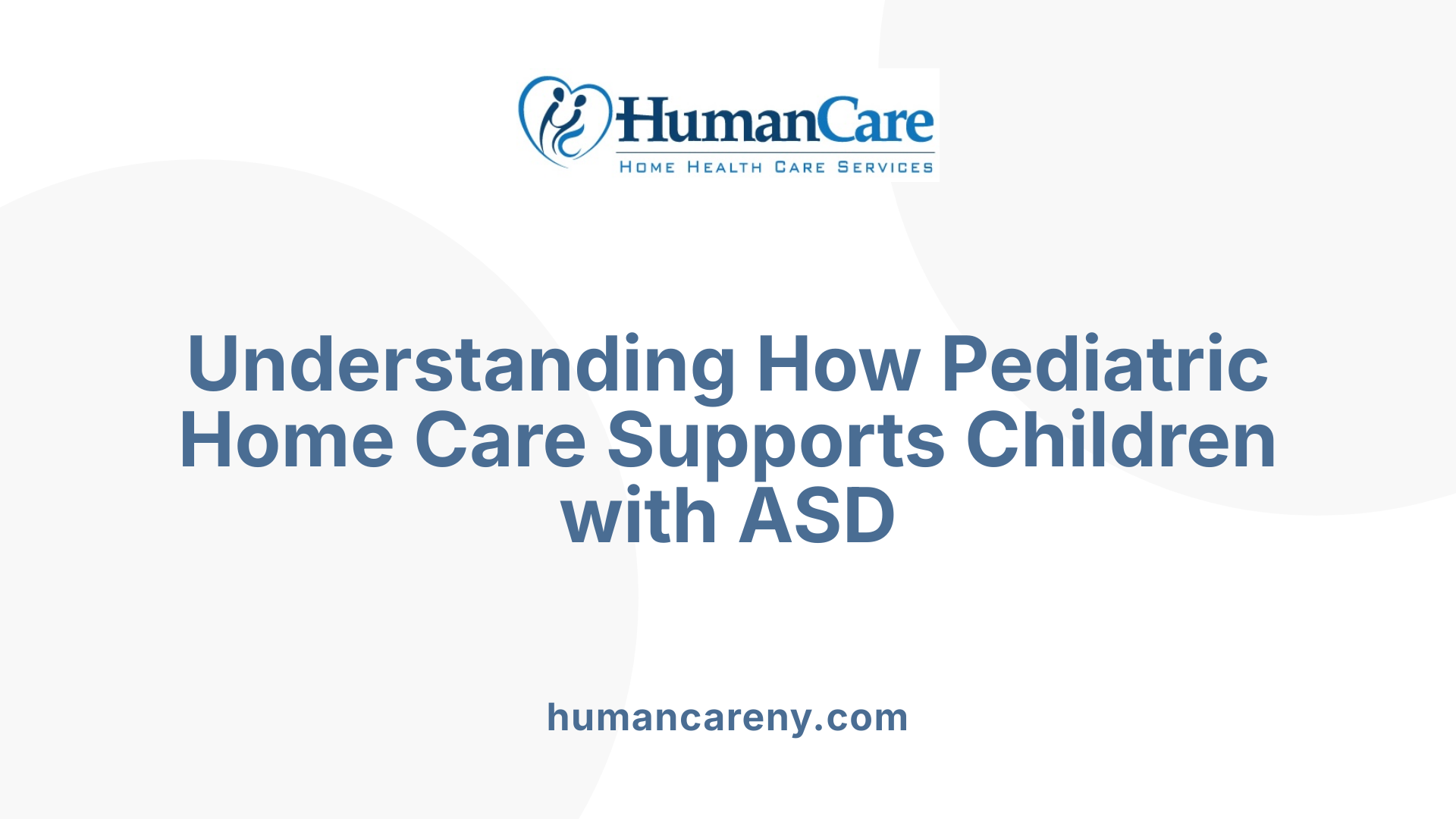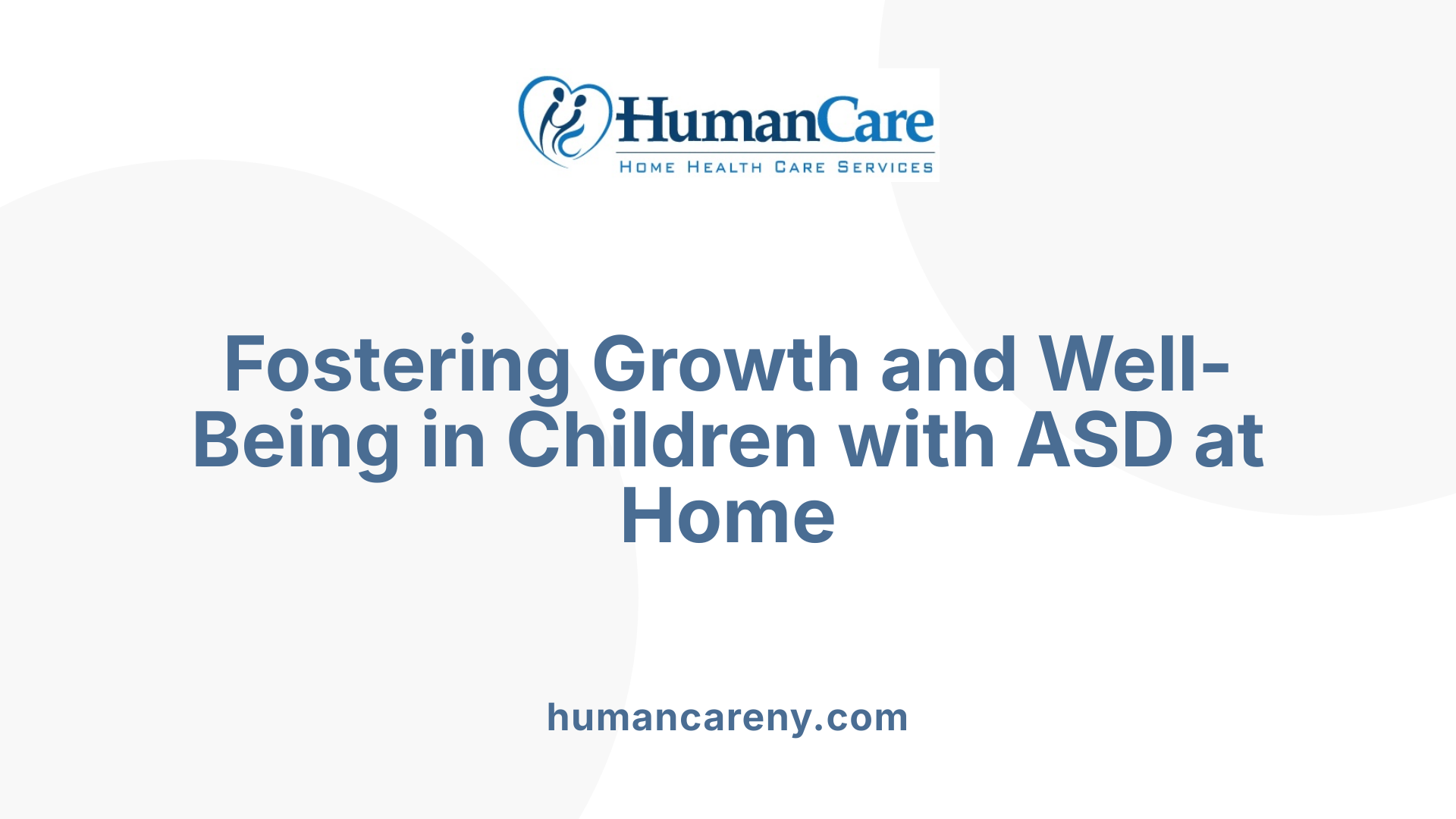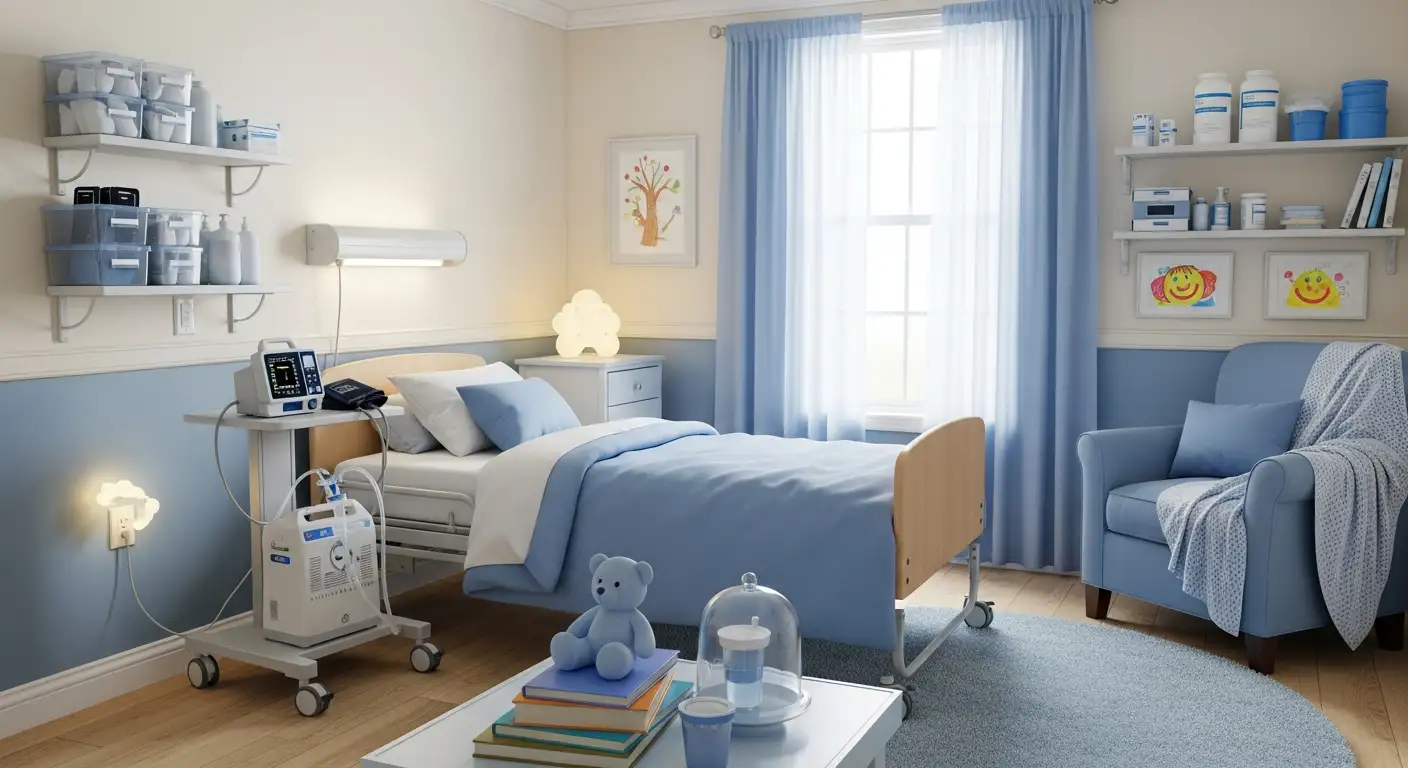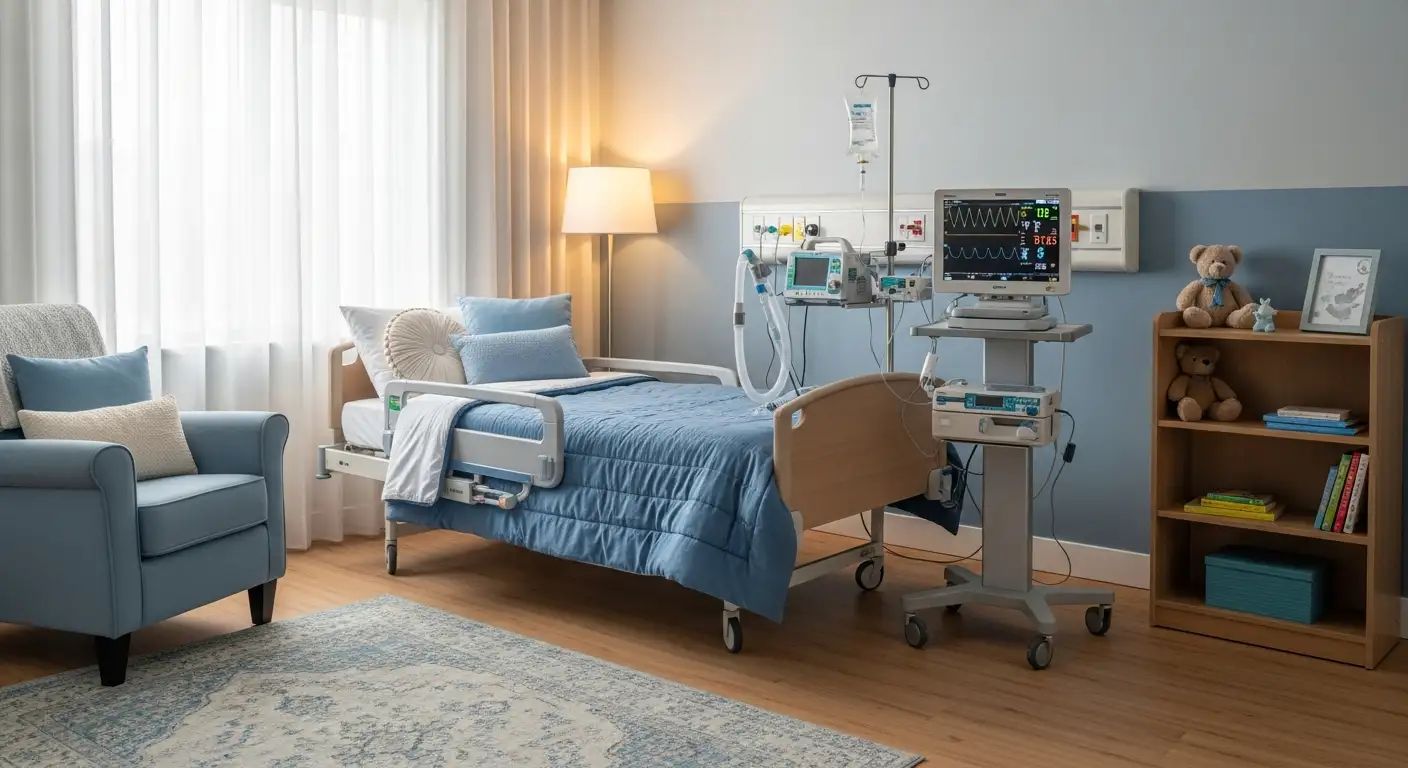The Essential Role of Pediatric Home Care in Autism Support
Pediatric home care plays a critical role in supporting children with autism spectrum disorder (ASD) by delivering tailored, comprehensive services in the familiar environment of the child's home. This approach not only promotes developmental progress but also enhances family involvement and well-being. Through coordinated therapies, medical care, and community support, home-based programs serve as a cornerstone for improving outcomes and quality of life for children with ASD and their families.
Understanding Pediatric Home Care for Children with ASD

What is pediatric home care for children with special health care needs?
Pediatric home care for children with special health care needs involves delivering medical, developmental, and supportive services directly in the child’s home environment. These services aim to manage complex health conditions, disabilities, and medical needs by utilizing a team of providers, family members, and caregivers. Equipment and supplies like adaptive devices help facilitate ongoing health, participation in daily activities, and developmental progress. This approach provides a safe and familiar setting for children, which can be especially beneficial for those with sensory processing difficulties or behavioral challenges.
Home health care is considered medically necessary because it allows continuous monitoring, supports complex care routines, and promotes overall well-being. It also integrates the child's learning and social development needs, enabling therapies and interventions to be part of daily life. Efforts are focused on creating family-centered and patient-centered care plans that foster partnerships among healthcare providers and families, aiming to address disparities and improve outcomes for children with medical and developmental complexities.
Recent advances in pediatric home care emphasize quality measurement, data-sharing initiatives, and evidence-based practices. These focus on ensuring equitable access to services regardless of socioeconomic or geographic barriers, ultimately supporting children’s health and development across home, school, and community settings.
How can home-based therapies and interventions support children with autism spectrum disorder (ASD)?
Home-based therapies and interventions are crucial for children with autism spectrum disorder (ASD). They offer a personalized approach that fits within the child’s familiar environment, promoting comfort and better learning responses.
Behavioral strategies such as Applied Behavior Analysis (ABA) target specific behaviors by reducing challenging actions and enhancing social and adaptive skills. Developmental therapies, including speech, occupational, and physical therapy, focus on improving communication, motor skills, and independence. These therapies can be delivered directly by trained caregivers or professionals in the home setting, which helps children generalize skills learned in therapy to everyday life.
Educational methodologies like TEACCH adapt the environment to support learning through structured routines and visual supports. Social-relational therapies, including social stories and group activities, nurture social skills and emotional bonds.
Involving families in therapy through training and co-therapy sessions enhances consistency, which is vital for progress. Technology-based interventions can offer additional support and accessibility, allowing families to maintain therapy routines and goals outside of formal sessions.
Early intervention and continuous support at home not only promote developmental gains but also help reduce anxiety and behavioral issues by creating predictable routines and familiar settings. This holistic, home-centered approach supports sustainable growth and enhances the child’s overall quality of life.
Additional Components of Effective Pediatric and ASD Care
| Component | Description | Benefit |
|---|---|---|
| Care Plans | Comprehensive plans that include educational services, therapies, medical issues, family supports, and crisis plans | Ensures coordinated, holistic support tailored to each child's needs |
| Care Notebooks | Used to document ongoing care and facilitate communication | Enhances team coordination and family engagement |
| Remote Support | Utilizes technology for accessible, multidisciplinary consultations | Expands access, reduces travel, and fosters collaboration |
| Parent and Caregiver Support | Programs and groups for respite and peer connection | Lowers stress, increases support networks |
| Home Visits | Regular scheduled visits for routine establishment and skill-building | Promotes learning, alleviates anxiety |
| Training for Providers | Specialized ASD knowledge for healthcare staff | Improves responsiveness and support |
Challenges and Opportunities in Pediatric and ASD Home Care
Despite the benefits, children with ASD and their families often encounter barriers like limited access to medical homes and specialty services. The organization of health and educational systems can place undue demands on families, who often act as coordinators.
Efforts such as targeted ABA programs, community collaborations, and policy initiatives aim to bridge these gaps. Programs like the HHS Children’s Autism Program provide structured ABA services and parent training, improving quality of life and clinical outcomes.
Incorporating technology, fostering partnerships, and expanding provider training are ongoing strategies to enhance home-based care. These initiatives seek to make quality, family-centered pediatric home care a standard accessible to all children with ASD, ensuring comprehensive support in their everyday environments.
The Impact of Medical Homes and Care Coordination

What is the medical home model, and how does it benefit children with autism spectrum disorder (ASD)?
A medical home is a comprehensive, family-centered approach to primary care that emphasizes accessible, continuous, and coordinated services tailored to each child's needs. According to the American Academy of Pediatrics, a well-structured medical home provides care that is not only medical but also includes educational support, family involvement, and community resource integration.
For children with ASD, the medical home plays a crucial role by ensuring that all aspects of their care—medical, developmental, and behavioral—are seamlessly integrated. This approach enhances treatment outcomes because it facilitates better communication among families, healthcare providers, and community agencies.
Children and their families who are part of a medical home tend to receive more of the recommended services, such as therapies, screenings, and family supports. Studies show that standard access to a medical home correlates with increased satisfaction levels and improved management of complex health needs.
How does care coordination among specialists, families, and community agencies improve outcomes?
Children with ASD often require the involvement of multiple specialists, including speech therapists, occupational therapists, behavioral clinicians, and medical professionals. Coordinating care among these parties within a medical home helps organize and streamline services, avoiding overlaps or gaps.
Effective care coordination ensures that families receive clear guidance on service eligibility, referral processes, and treatment plans. It also involves regular communication and updates about the child's progress, which can be tracked using tools like care notebooks—personalized records that document ongoing care, appointments, and therapies.
Communication among healthcare providers, families, schools, and community agencies fosters collaborative decision-making. This teamwork helps tailor interventions to the child’s evolving needs, minimizing stress and confusion for families.
How are care plans and communication tools like care notebooks utilized?
Central to good care coordination is the development of individualized care plans. These plans typically encompass educational services, medical treatments, therapies, emergency procedures, and family supports.
Care notebooks serve as practical tools that document a child's health and behavioral information, track appointments, and record progress. They facilitate effective communication during medical visits or school meetings, ensuring everyone involved has up-to-date information.
This organized communication enhances consistency in the child's daily routines and ensures that all involved parties are aligned in their approaches, reducing behavioral issues and promoting stability.
What challenges exist in providing consistent and comprehensive care?
Despite evidence pointing to the benefits of medical homes, many children with ASD do not have consistent access to such comprehensive services. Barriers include shortages of trained providers, fragmented healthcare and educational systems, and disparities based on socioeconomic and geographic factors.
Families often face difficulties in obtaining referrals and navigating complex service systems, which can lead to unmet medical or educational needs. Additionally, some caregivers report a lack of shared decision-making, limiting their involvement in care planning.
Addressing these challenges requires systemic changes to healthcare organization, increased provider training, and policies that support equitable access. Enhancing technological solutions, like telehealth and remote support, can also bridge some gaps, offering improved access to specialists and ongoing guidance.
| Component | Description | Additional Notes |
|---|---|---|
| Medical Home | Family-centered, comprehensive primary care | Adds coordination, accessibility, and continuity |
| Care Coordination | Organizing care among multiple providers | Uses tools like care notebooks and shared communications |
| Care Plans | Personalized treatment and educational strategies | Encompasses therapies, emergency plans, and supports |
| Challenges | Barriers to consistent care access | Includes resource shortages and systemic fragmentation |
Efforts underway aim to integrate medical and educational services more effectively, support family needs, and create accessible, high-quality care environments for every child with ASD.
Supporting Development and Well-Being through Home Care

What are the benefits of pediatric home care services for children with autism spectrum disorder?
Pediatric home care services offer numerous advantages for children with autism spectrum disorder (ASD) by delivering customized support directly within the child's familiar surroundings. This approach allows for the integration of tailored therapies such as behavioral interventions, speech therapy, and occupational therapy into daily routines, which maximizes their effectiveness.
Home care providers are trained to handle the unique needs of children with ASD, ensuring consistent application of therapeutic strategies and facilitating coordination with educational institutions and community resources. This collaboration helps maintain continuity in learning, social interaction, and developmental progress.
Living environments are often sensory-friendly compared to clinical settings, helping children feel more comfortable and less overwhelmed. This reduction in sensory overload can improve emotional regulation and reduce behavioral challenges.
Another significant benefit is the active involvement of family members. Being part of the therapy process strengthens family bonds, enhances understanding of the child's needs, and encourages caregivers to reinforce strategies consistently. This holistic, family-centered care promotes overall well-being and development.
How do home care programs contribute to the development and well-being of children with ASD?
Home care programs play a vital role in fostering the development and emotional health of children with ASD by providing ongoing, individualized interventions targeted at key areas such as communication, social skills, and daily living routines. These programs tailor support based on each child's unique profile, adapting techniques as they grow and change.
Involving families directly through training and coaching, such as through the WHO's Caregiver Skills Training (CST), enhances their confidence and reduces caregiving stress. When caregivers learn evidence-based methods like Applied Behavior Analysis (ABA), social stories, and sensory regulation activities, they can effectively support their child's ongoing development.
Remote support options further improve access, especially for families facing difficulties with transportation, distance, or limited local resources. Telehealth services enable real-time consultations, progress monitoring, and shared planning, ensuring that children receive consistent care regardless of location.
This integrated approach—combining specialized professional support with active family participation—creates a nurturing environment that promotes skill acquisition, emotional regulation, and social engagement. These environments nurture resilience and foster positive growth trajectories.
Role of home programs in skill development and emotional support
Home programs serve as a foundation for continuous skill development aligned with each child's abilities. These programs emphasize consistency, structure, and reinforcement of learned behaviors to help children build independence, communication, and social skills.
Activities are designed to be engaging and suited to individual preferences, which supports motivation and participation. Caregivers are trained to observe and respond to sensory sensitivities and behavioral cues, minimizing stress and promoting calmness.
Emotional support is embedded in every aspect of home programs through routine establishment, predictable environments, and positive reinforcement. These elements reduce anxiety, increase trust, and help children feel secure.
Involvement of families and caregivers in therapy and training
Families and caregivers are central to effective home-based interventions. Their active involvement ensures consistency between therapy sessions and daily routines, leading to better generalization of skills.
Training sessions equip caregivers with techniques to manage behaviors, teach new skills, and create supportive environments. This empowerment fosters a sense of control and reduces caregiver stress.
Regular communication with therapy professionals allows caregivers to share insights, ask questions, and adapt strategies as needed. This partnership builds a cohesive support network that is vital for the child's success.
The importance of individualized, evidence-based interventions
Each child with ASD has a unique profile, requiring interventions tailored to their specific strengths and challenges. Evidence-based practices like ABA, social skills training, and sensory integration are adapted for each individual.
Personalized programs increase engagement and efficacy, ensuring that interventions are meaningful and effective. They also facilitate the child's progress in key areas such as communication, social interaction, and daily routines.
Remote support and telehealth innovations
Advancements in telehealth have revolutionized access to home-based ASD support. Video conferencing, mobile apps, and online training modules enable families to connect with specialists remotely.
Remote services allow for ongoing assessment, coaching, and parent training without the need for travel. This flexibility helps maintain consistent participation, especially in rural or underserved areas.
Innovations include interactive platforms for social skills practice, virtual reality environments for sensory regulation, and digital monitoring tools to track progress.
To ensure success, implementing remote support requires reliable internet access, professional training in telehealth delivery, and robust data security measures. These technologies must also be culturally sensitive and tailored to meet diverse family needs.
Overall, remote support enhances the reach and quality of home programs, fostering sustainable development and emotional resilience in children with ASD.
Types of Services and Evidence-Based Practices

What types of services are typically offered through pediatric home care programs for children with ASD?
Pediatric home care programs designed for children with autism spectrum disorder (ASD) aim to provide a broad spectrum of personalized services directly in the child’s home environment. These services include behavioral therapies like applied behavior analysis (ABA), which help improve social skills, communication, and reduce challenging behaviors.
Speech therapy and occupational therapy are also common components, addressing language development, sensory processing, motor skills, and daily living activities. Developmental interventions integrated into home care focus on supporting cognitive, social, and emotional growth tailored to each child's needs.
Medical support services such as nursing care assist with managing health issues, medication administration, and monitoring medical conditions. Assistance with activities of daily living—including bathing, feeding, dressing, and hygiene—is provided to promote independence.
Respite care is offered to give families temporary relief from caregiving duties, reducing stress and preventing burnout. Early intervention services for young children help promote foundational skills early in life.
Moreover, support navigating educational and community resources ensures children can access therapies and programs suited to their needs. Many programs are funded through Medicaid waivers, which allow for in-home care, transportation, and advanced assistive technologies.
Overall, the goal is to ensure comprehensive, flexible, and family-centered care that fosters developmental progress, safety, and family well-being in familiar surroundings.
Are there evidence-based practices supporting the role of home care in supporting children with ASD?
Yes, a wealth of research supports the effectiveness of evidence-based practices in home-based ASD care. Naturalistic developmental behavioral interventions (NDBIs), such as the Early Start Denver Model and JASPER (Joint Attention, Symbolic Play, Engagement, and Regulation), emphasize learning through play and everyday routines. These approaches involve caregivers actively in therapy, promoting generalization of skills across settings.
Parent-mediated interventions, including programs like Project ImPACT and JASPER, empower families to implement therapy strategies consistently. Studies have shown that such approaches improve children's social communication, adaptive behaviors, and reduce behaviors that challenge families.
Remote support models, including telehealth consultations and virtual coaching, are also supported by evidence. They improve access for families living in remote areas, assist in maintaining therapy routines, and reduce caregiver stress.
Overall, these practices demonstrate that individualized, family-centered strategies rooted in scientific evidence significantly benefit children with ASD. Applying these approaches within home care allows for natural learning opportunities and reinforces consistent skill development.
| Service Component | Description | Supporting Evidence |
|---|---|---|
| Behavioral Therapy | Applied Behavior Analysis (ABA), naturalistic interventions | Strong evidence links ABA to improved social and adaptive skills |
| Speech & Language Therapy | Enhances communication abilities | Widely supported through research showing improvements in language skills |
| Occupational Therapy | Supports sensory processing and daily skills | Studies indicate benefits in sensory regulation and motor development |
| Medical Support | Nursing, medication management | Critical for managing health issues, comorbidities |
| Respite Care | Temporary caregiver relief | Reduces stress and supports sustainable caregiving |
| Assistive Technologies | Communication devices, sensory tools | Proven to aid communication and environmental regulation |
How do these practices support children’s overall development and family well-being?
Implementing evidence-based home care practices promotes not only the child's development but also enhances family stability and well-being. Children benefit from consistent routines, tailored therapies, and familiar settings that reduce anxiety and facilitate learning.
Families experience increased confidence as they learn to implement therapeutic strategies, fostering a sense of competence and empowerment. The support reduces caregiver stress by offering respite options and effective management techniques.
Through continuous communication and collaboration among healthcare providers, educators, and community services, families can navigate complex service systems more efficiently. This integrated approach ensures that children with ASD receive holistic support, aiding their transition into community and educational settings.
In summary, grounding home care in scientifically supported practices creates a nurturing environment that maximizes developmental gains for children while supporting families in their caregiving journey.
Fostering a Brighter Future for Children with ASD through Home Care
In conclusion, pediatric home care offers comprehensive, evidence-based, and family-centered support that plays a vital role in the development and well-being of children with autism spectrum disorder. From personalized therapies to coordinated medical and educational services, home-based programs foster a nurturing environment where children can thrive. Empowering families through training, remote support, and integrated care models ensures that children with ASD receive not only the necessary interventions but also the emotional and practical support that sustains their growth. As awareness and accessibility improve, home care will continue to be an essential component in building a supportive ecosystem that promotes lifelong success for children with ASD.
References
- The Medical Home for Children With Autism Spectrum Disorder ...
- Enhancing autism care through remote support: A family-centered ...
- The Medical Home for Children With Autism Spectrum Disorder
- Program Supports Parents and Caregivers of Children With ASD
- Autism and pediatric practice: toward a medical home - PubMed
- The Benefits of Home Care Services for Autistic Children
- Meeting the Needs of Children With Autism Spectrum Disorder and ...
- Treatment and Intervention for Autism Spectrum Disorder - CDC
- Is medical home care adequacy associated with educational service ...



